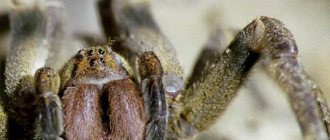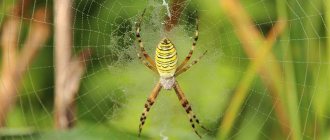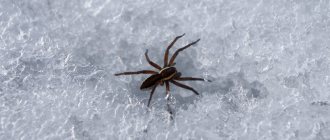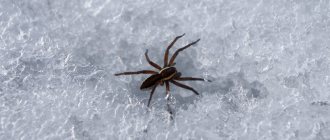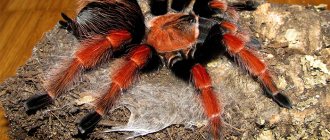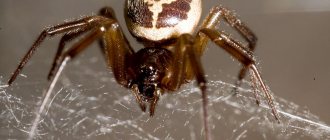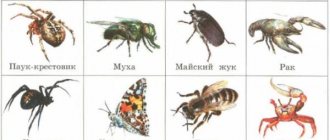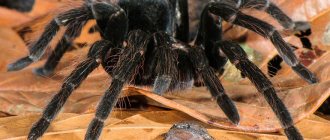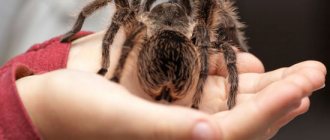Marriage ritual
The reproductive process of spiders begins with a mating ritual, as is often the case in the animal world. The methods of male courtship are very diverse:
- some species hypnotize the female with rhythmic leg movements;
- twitching the abdomen;
- peacock spiders from the jumping family reveal a colorful “fan” on their abdomen;
- Some specimens bring the lady of the heart a “gift” - prey wrapped in a web.
- wolf spiders circle around the female, getting closer;
- the male karakurt pulls the threads of the female's web in a certain rhythm, as if ringing a doorbell;
- Attids living in Canada “dance”, making intricate movements with their limbs.
Mating dance
Interesting fact! Males secrete special aromatic substances - pheromones, which attract females only of their own species.
All the tricks of males are aimed at ensuring that the female is favorable, and in some cases, so that she does not eat them ahead of time.
Classification of arachnids
This class includes about 10 units. Which is approximately 100 thousand species of various representatives. The diversity of the class is amazing. Their relationship is confirmed by molecular biological and morphological data.
A little earlier, reeds and tardigrades were classified as arachnids; now they are considered as a separate family of the class. The status of the mite order is still in question. The outstanding acarologist A. A. Zakhvatkin made a proposal to divide ticks into 3 independent orders. Currently, leading acarologists cannot come to a consensus on this matter.
Orders of arachnids:
- false scorpions;
- scorpions;
- flagipods;
- spiders;
- haymakers;
- harvest mites;
- parasitiform mites;
- acariform mites;
- salpugs;
- mites;
- schizomids;
- phalanges;
- Phrynes;
- ricinulei.
These are modern units. Anthracomarti is one of the groups that is extinct today. The external structure of its representatives is reminiscent of modern phrynes and haymakers.
Pairing
Scientists have described in detail the process of how spiders mate. A distinctive feature of these creatures is the presence of pedipalps.
On a note! Pedipalps, or claws, are modified short oral limbs in chelicerates, which, in addition to spiders, also include horseshoe crabs and sea spiders.
Before the last molt, which signifies the final maturation of the male individual, the endings of the pedipalps become containers for seminal fluid. The spider weaves a mesh (usually triangular) and squeezes sperm out of the gonads there. The mesh with genetic material is placed in the copulatory (intended for mating) process of the pedipalp - the embolus.
When a female accepts courtship from a male, the embolus is placed in a special hole on her abdomen - the spermatheca. It often happens that the sperm reservoir breaks off, so that the male becomes unable to fertilize more than one female.
Myth 11: Letting spiders outside is a good idea.
Image: michael podger / Unsplash
Many people, even if they don't like spiders, feel compassion for them. After all, killing a living creature, no matter how frightening it is, is not a good thing. Not wanting to take the sin to heart, compassionate citizens do not beat the arthropod found on the ceiling with a slipper, but brush it off with a newspaper and release it into the fresh air.
After all, all creatures in the wild are better off, right?
In fact, by throwing a spider out of your home, you will most likely doom it to death: domestic arthropods are not adapted to living on the street. Arachnologist Rod Crawford explains to Myth: “I'm very kind to spiders; when I find one in the house, I put it back outside instead of killing it” / Burke Museum, that most of the spiders that you can meet in different buildings live there their entire lives. About 25 of their species always live in the underground, voids in the walls and abandoned rooms. And they never saw the open sky.
So if you want to save the spider’s life, it’s better to throw it into the entrance, garage, or even a shed if you have a private house - there it has a better chance of surviving.
Spiders do not come into houses in the fall to get out of the cold / Burke Museum, they do not need artificial shelters. Household and garden arthropods are completely different species. And the first ones, finding themselves in the habitat of harsh wild monsters, will most likely be killed. And not by the cold, but by their own brothers. They are simply not used to competition.
How do spiders lay eggs?
The spider lays eggs through the oviduct, placing them in a cocoon for protection from enemies and maintaining an optimal temperature. The cocoon bag is woven from a spider's web and is usually about the size of a spider.
Since spiders are oviparous, they do not directly give birth. You can see what spider eggs look like if you remove the cocoon from them.
Interesting fact! Spider eggs can come in all colors of the rainbow.
Spiders that live in burrows hide them by attaching them to the walls. Representatives of funnel-worms, bagworms, and many side walkers do this. Sometimes you can see a spider with an egg. Most likely, this female tarantula or other wolf spider carries a spherical cocoon containing about 50 fertilized eggs. The spider actively protects its offspring; approaching it is dangerous.
Spider clutch
Interesting fact! The eggs of some species of spiders can be poisonous to mammals, including humans. This has nothing to do with the toxicity of adults.
External and internal structure
Most arachnids consist of a cephalothorax, abdomen and have 6 pairs of limbs, one pair - chelicerae, located in front of the oral apparatus. They are shorter than others, end in a hook or claw, and consist of 2-3 segments. The second pair, the pedipalps, are located behind the mouth. If necessary, they perform the function of walking legs, and at the same time they are organs for capturing food. The remaining 4 pairs of limbs are walking. All legs are located on the cephalothorax, the abdomen does not carry limbs.
It is not possible to dismember the head and chest, since they are connected in the spider . Arachnids have no antennae or antennae at all. These are the main characteristics of arthropod representatives.
Arachnids have specific warts on their abdomen. They are called cobwebs. There are more than 1 thousand of them.
They produce a special liquid that hardens when it comes into contact with oxygen. Next, it turns into a catching web.
Features of digestion
The spider has an extraintestinal digestive system. When the prey is caught, the hunter pierces a pair of chelicerae into its body and injects poison. After the prey is disarmed, the hunter wraps it in a web and introduces the secretion of the salivary glands under its chitinous cover. After a short time, the insides of the victim turn into a nutritious cocktail, which the hunter simply sucks up. Solid food is not available to him.
The extraintestinal digestive system of the spider consists of several types of intestines:
- anterior - consists of the pharynx, crop and sucking stomach, which is equipped with very strong muscles. It works on the principle of a rubber bulb, so the spider easily absorbs already digested food from the outside;
- medium - the main function is the absorption of nutrients. There are numerous outgrowths on the surface that help increase the suction areas;
- the posterior one - its end - the anus, it is through this route that the remains of the spider’s vital activity are eliminated.
For most of its existence, the spider hunts and weaves webs, so it has very little time to rest. In one day, arachnids eat about 10 insects.
Blood circulation and breathing
The respiratory system consists of many tracheas and pulmonary sacs, through which oxygen enters the tissues and organs. Accordingly, carbon dioxide is removed in the same way.
Structure of the respiratory tract:
- pulmonary sacs - modified skin outgrowths, shaped like parallel partitions;
- trachea - breathing tubes, the end of which are special stigmas or spiracles in the form of holes. They are located on the surface of the spider's body. They are placed in pairs. The inner walls of the trachea are protected by a chitinous membrane.
The blood circulation of articulated animals is lacunar or open type.
The heart functions in the same way as in crustaceans. The tissues and organs of the spider are washed by hemolymph.
Circulatory system:
- the heart has the shape of a tube. Located in the pericardial sac or pericardium;
- aorta and arteries - come from the heart, hemolymph circulates through them.
The spider's circulatory system is not involved in the transfer of oxygen. It is simplified by the tracheas, which are responsible for this process.
In addition, a distinctive feature of the structure of the spider’s circulatory system is that it completely lacks capillaries and small vessels. Thus, the circulatory system only delivers nutrients to the organs and tissues of the spider.
Excretory and reproductive systems
Arachnids have special excretory organs - Malpighian vessels. This is a thread-thin organ that represents the blind end of the outgrowths at the end of the intestine. The border of their ending is between the midgut and hindgut.
Their function is to absorb water from urine, which at the exit has a crystalline appearance and is excreted from the body in the form of sediment, so the spider’s waste is always in a solid state.
The arachnid family belongs to heterosexual animals, so their fertilization is internal . The reproductive organs of males are the testes, and those of females are the ovaries. The fertilization process occurs in two ways. The first is that the male collects seminal fluid into a special sac, which the female grabs with the edges of the genitals. The second way is that the sperm enters directly into the female’s genital tract with the help of the male’s copulatory organs.
Spider Sense Organs
The hearing organs of spiders are auditory vesicles. 8 paired eyes are responsible for vision. The entire body is equipped with special bristles (hairs). With their help, the insect feels even the slightest vibrations in the air.
The nervous system consists of the brain and the subpharyngeal ganglion, which are connected to each other by a connective . Together, these structures form the representative peripharyngeal nerve ring. From it, a chain of nerves runs along the abdomen, which merge together into one star-shaped node.
Number of eggs in clutch
The female spider first weaves a dense web of cobwebs, and eggs are laid there. Then the masonry is covered with a second layer of web, resulting in a dense cocoon.
The clutch of spiders varies depending on the species. One egg is laid by the microscopic Pyrenean spider Telema tenella. Agryope Brünnich can lay up to a thousand eggs at a time. The female tarantula Lasiodora parahybana brings from 1.5 to 2.5 thousand eggs.
On average, a clutch contains 20-30, sometimes 50 fertilized eggs.
The shape of the cocoon can be different:
- in the form of a ball;
- cone;
- pyramids;
- star-shaped;
- etc.
The masonry of Agroeca brunnea has an interesting shape - two chambers are connected to each other like a glass. The eggs develop in one chamber, and the hatched little spiderlings move into the other.
Interesting fact! Not all eggs in a clutch are fertilized. If most of the eggs are empty, the female can eat the cocoon.
Myth 2. Wherever you are, there is a spider a meter away from you
Image: Egor Kamelev / Unsplash
Another popular internet horror story that terrifies arachnophobes. Allegedly, statistics know for sure that spiders are everywhere in the world. And one meter away from you - well, or a foot, three feet or six feet - it’s as if a furry eight-legged killing machine is sitting and ominously rubbing its chelicerae. And then how he jumps!
This myth apparently originated with Myth: You are never more than three feet from a spider / The Burke Museum in 1995 due to the words of arachnologist Norman Platnik, who wrote in one article: “Wherever you sit reading these lines, at least one spider will probably be no more than a few yards away from you.”
There are, of course, a lot of spiders in the world - science now knows Types of Spiders & Spider Facts / Live Science 40,000 species of these arthropods. However, we have only discovered about 10%, and they live on all continents except Antarctica. It’s just not at all necessary that at least one is near you right now.
Of course, if you're sitting on the lawn, there are probably spiders in the grass. But in winter, of course, they won’t be there. Likewise, in an office in a high-rise building, spiders will be much more rare guests than in a country house.
No one has ever Myth: You are never more than three feet from a spider / The Burke Museum done the calculation to find out how far away the average spider is from the average person. And Norman Platnik just pulled a number out of thin air to add an effective phrase.
Birth of spiderlings
Eggs mature over several weeks. As a rule, the female guards the clutch all this time. Spiders are born, or rather hatch, from eggs ranging in size from 2 mm (in Cyclosternum) or with a paw span of up to 1.5 cm (in the goliath tarantula Theraphosa blondi).
Interesting fact! Spiderlings of arboreal species mature faster than their relatives, but there are significantly fewer of them in the clutch.
Stages of development of spiders inside the cocoon:
- The first molt occurs inside the egg. The newborn spider feeds on the yolk of the egg. This stage is called “prelarva”.
- Then another molt occurs, the spiders turn into first-stage nymphs. Their covers are still very thin and are not able to protect them from the external environment, so development continues to take place inside the cocoon.
- After 3-5 weeks, a larva appears - a nymph of the second stage. Such an individual cannot yet feed on its own, but claws on its paws and chelicerae are already developing.
- The next molt is considered postembryonic. Spiders are becoming more and more active. With small spines on the pedipalps they tear the cocoon and emerge into the light. Newly born spiderlings initially stay in a group, then scatter.
Female tarantulas themselves open their cocoons, helping the cubs get out. The Argiope cocoon has very thick walls. Spiderlings dissolve part of the cocoon using enzymes contained in saliva.
Features of the species
The life of spiders at the growing stage depends on their species.
- The crosses remain in the sunny meadow as a whole for a long time.
- Tarantulas travel through their habitat on the back of their mother, falling off from there themselves or through her efforts.
- The wolves stay on the spider’s belly, but not for long. They cling to everything, including cobwebs.
- Sidewalkers begin to jump as soon as their legs become stronger. They move actively front, back and side.
- Segestria sit in burrows for a long time, and crawl away when the yolks run out and there is not enough food.
Spiders.
Further fate
Almost all species of spiders stop caring for their offspring as soon as the young spiders emerge from the cocoon. Females of some species die before the birth of their young and serve as food for them for the first time.
Pauchata
The exception is tarantula spiders of the genus Hysterocrates, described at the end of the 19th century. British scientists. They live on the small island of Sao Tome in the Atlantic Ocean. Spiders are in no hurry to leave their mother and live with her for several months. The female continues to take care of the offspring, obtains food for them, and protects them.
Typically, young spiders lead the same lifestyle as adults: they make burrows and hunt. Their prey is of a smaller size suitable for them. During its life, the spider goes through several molts until it reaches the state and size of an adult sexually mature individual.
Interesting fact! Typically, male spiders live much shorter than females and they also molt less often.
general characteristics
Representatives of the type of arthropods from the class of arachnids can be found almost everywhere: in a person’s house, in a forest, in a field, in a yard. They have adapted to different living conditions. Among them there are often species that lead a parasitic lifestyle, attaching themselves to the animal’s body and feeding on its blood. They live mainly in the air-terrestrial environment, less often in the aquatic environment.
Most arachnids are predators. Their main diet consists of insects.
Characteristics of arthropods:
- the body is divided into several sections;
- the outer shell is strictly chitinous;
- all limbs are articulated.
It is believed that it was spiders who were the first to initially populate the land, so their body structure has special adaptations that help them survive in harsh above-ground conditions.
This is especially true in regions where water is the most valuable resource and the likelihood of drying out is very high.
Why does a black widow eat her male?
Its main goal is to fertilize the female; when he succeeds, his resources, as a rule, are already running out. After mating (and even during the process), the male finds himself in the jaws of the female; she digests it and thereby provides nutrition for future offspring.
Interesting materials:
What is juicy fruit? What are salt baths? What is solar activity and what is the phenomenon of cyclical solar activity? What is resistance? What is voltage? What are related products? What is a social network? What are social everyday epics? What is socio-economic development? What are modern means of communication? What is a modern lesson?
The classification of spiders is still controversial among scientists
Numerous classification schemes were published in the 1930s, most of them in response to Alexander Petrunkevich's scheme, but none are currently acceptable or relevant. All classifications were largely based on the work of Eugene Simon, published in France at the end of the 19th century. New tools such as scanning electron microscopy and molecular techniques have changed traditional classification schemes. In addition, many new spiders have been discovered in the Southern Hemisphere that do not fit easily into established families, a situation that has prompted new classifications to be proposed. The best studied species are those living in Europe, North America, Korea and Japan.


